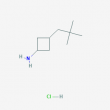
3-(2,2-Dimethylpropyl)cyclobutan-1-amine hydrochloride - 100mg
Short description
3-(2,2-Dimethylpropyl)cyclobutan-1-amine hydrochloride
Discover the exceptional versatility of 3-(2,2-Dimethylpropyl)cyclobutan-1-amine hydrochloride, a premium-quality chemical compound with a purity of at least 95%. This unique molecule, bearing the CAS number 2460754-99-6, offers a molecular weight of 177.7 g/mol, making it a valuable asset for your advanced research and development projects. Crafted with precision, this compound's distinct structure and properties unlock a world of possibilities in various applications, from pharmaceuticals to specialty chemicals. Unlock the potential of this remarkable building block and elevate your experiments to new heights of success.
- CAS: 2460754-99-6
- Molecular Weight: 177.7 g/mol
- Purity: Min. 95%
- MDL Number: MFCD32703190
-
Procurenet Team Tshim Sha Tsui
Hong Kong 3 years
Description
3-(2,2-Dimethylpropyl)cyclobutan-1-amine hydrochloride
Unlock the versatile potential of 3-(2,2-Dimethylpropyl)cyclobutan-1-amine hydrochloride, a meticulously crafted chemical compound that holds the key to unlocking new frontiers in scientific research and development. This highly pure and specialized substance, identified by its CAS number 2460754-99-6, is a valuable asset for researchers and chemists seeking to explore the boundless possibilities of cyclic amines.
At the heart of this compound lies a unique molecular structure, featuring a cyclobutane ring fused with a 2,2-dimethylpropyl substituent and a primary amine group. This intricate arrangement endows 3-(2,2-Dimethylpropyl)cyclobutan-1-amine hydrochloride with a distinct set of chemical properties, making it a versatile tool in a wide range of applications.
Pharmaceutical Research: Unlocking New Therapeutic Avenues
In the realm of pharmaceutical research, this compound serves as a crucial building block in the synthesis of innovative drug candidates. Its cyclic amine moiety and strategic substitution patterns offer researchers a versatile platform to explore novel therapeutic approaches, targeting a diverse array of health conditions. From neurological disorders to metabolic diseases, the unique properties of 3-(2,2-Dimethylpropyl)cyclobutan-1-amine hydrochloride hold the potential to unlock new frontiers in pharmaceutical development.
Researchers can harness the compound's reactivity and selectivity to design and synthesize tailored molecules with enhanced pharmacological profiles, improved bioavailability, and targeted therapeutic efficacy. By leveraging the intricate structural features of this compound, scientists can unlock new possibilities in the quest for more effective and safer treatments.
Agrochemical Innovation: Cultivating a Greener Future
Beyond the pharmaceutical realm, 3-(2,2-Dimethylpropyl)cyclobutan-1-amine hydrochloride also finds its place in the dynamic field of agrochemical development. Its distinct chemical properties contribute to the synthesis of advanced crop protection agents, enabling the creation of potent and selective pesticides that safeguard crops while minimizing environmental impact.
The compound's cyclic amine structure and strategic substitution patterns can be strategically employed to engineer agrochemicals with enhanced efficacy, specificity, and environmental compatibility. By incorporating 3-(2,2-Dimethylpropyl)cyclobutan-1-amine hydrochloride into their research and development efforts, agrochemical scientists can unlock new possibilities in the quest for sustainable and eco-friendly solutions that promote healthier crops and higher yields.
Chemical Synthesis: Unlocking the Potential of Novel Compounds
In the broader realm of chemical synthesis, 3-(2,2-Dimethylpropyl)cyclobutan-1-amine hydrochloride serves as a versatile building block for the creation of a wide array of novel compounds. Its unique structural features and chemical reactivity make it a valuable tool in the hands of skilled chemists, enabling the development of materials and substances with tailored properties and functionalities.
Whether it's the synthesis of advanced polymers, the formulation of specialized coatings, or the exploration of new catalytic systems, this compound's versatility unlocks a world of possibilities. By leveraging its distinct characteristics, researchers can unlock new frontiers in material science, energy technology, and beyond, driving innovation and progress across diverse scientific disciplines.
Technical Specifications and Handling
3-(2,2-Dimethylpropyl)cyclobutan-1-amine hydrochloride boasts a purity of at least 95%, ensuring reliable and consistent results in your research endeavors. Its molecular weight of 177.7 g/mol and MDL number MFCD32703190 provide a unique identifier for easy reference and traceability.
When handling this compound, it is essential to follow standard laboratory safety protocols. Appropriate personal protective equipment, such as gloves, lab coat, and eye protection,
Specifications
- Mdl: MFCD32703190
- Molecular weight: 177.7 g/mol
- Purity: Min. 95%





